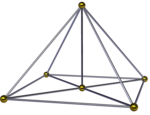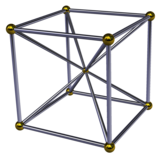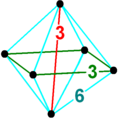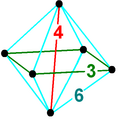Octahedral pyramid
| Octahedral pyramid | ||
|---|---|---|
 Schlegel diagram | ||
| Type | Polyhedral pyramid | |
| Schläfli symbol | ( ) ∨ {3,4} ( ) ∨ r{3,3} ( ) ∨ s{2,6} ( ) ∨ [{4} + { }] ( ) ∨ [{ } + { } + { }] | |
| Cells | 9 | 1 {3,4} 8 {3,3} |
| Faces | 20 {3} | |
| Edges | 18 | |
| Vertices | 7 | |
| Dual | Cubic pyramid | |
| Symmetry group | B3, [4,3,1], order 48 [3,3,1], order 24 [2+,6,1], order 12 [4,2,1], order 16 [2,2,1], order 8 | |
| Properties | convex, regular-faced | |
In 4-dimensional geometry, the octahedral pyramid is bounded by one octahedron on the base and 8 triangular pyramid cells which meet at the apex. Since an octahedron has a circumradius divided by edge length less than one,[1] the triangular pyramids can made with regular faces (as regular tetrahedrons) by computing the appropriate height.
Occurrences of the octahedral pyramid
The regular 16-cell has octahedral pyramids around every vertex, with the octahedron passing through the center of the 16-cell.
The octahedral pyramid is the vertex figure for a truncated 5-orthoplex, ![]()
![]()
![]()
![]()
![]()
![]()
![]()
![]()
![]() .
.
Other polytopes
The dual to the octahedral pyramid is a cubic pyramid, seen as an cubic base, and 6 square pyramids meeting at an apex.
Square-pyramidal pyramid
| Square-pyramidal pyramid | ||
|---|---|---|
  Schlegel diagrams | ||
| Type | Polyhedral pyramid | |
| Schläfli symbol | ( ) ∨ [( ) ∨ {4}] [( )∨( )] ∨ {4} = { } ∨ {4} { } ∨ [{ } × { }] { } ∨ [{ } + { }] | |
| Cells | 6 | 2 square pyramid 4 {3,3} |
| Faces | 12 {3} 1 {4} | |
| Edges | 13 | |
| Vertices | 6 | |
| Dual | Self-dual | |
| Symmetry group | [4,1,1], order 8 [4,2,1], order 16 [2,2,1], order 8 | |
| Properties | convex, regular-faced | |
The square-pyramidal pyramid, ( ) ∨ [( ) ∨ {4}], is a bisected octahedral pyramid. It has a square pyramid base, and 4 tetrahedrons along with another one more square pyramid meeting at the apex. It can also be seen in an edge-centered projection as a square bipyramid with four tetrahedra wrapped around the common edge. If the height of the two apexes are the same, it can be give a higher symmetry name [( ) ∨ ( )] ∨ {4} = { } ∨ {4}, joining an edge to a perpendicular square.[2]
The square-pyramidal pyramid can be distorted into a rectangular-pyramidal pyramid, { } ∨ [{ } × { }] or a rhombic-pyramidal pyramid, { } ∨ [{ } + { }], or other lower symmetry forms.
The square-pyramidal pyramid exists as a vertex figure in uniform polytopes of the form ![]()
![]()
![]()
![]()
![]()
![]()
![]()
![]()
![]() , including the bitruncated 5-orthoplex and bitruncated tesseractic honeycomb.
, including the bitruncated 5-orthoplex and bitruncated tesseractic honeycomb.
References
- ^ Klitzing, Richard. "3D convex uniform polyhedra x3o4o - oct". 1/sqrt(2) = 0.707107
- ^ Klitzing, Richard. "Segmentotope squasc, K-4.4".
External links
- Olshevsky, George. "Pyramid". Glossary for Hyperspace. Archived from the original on 4 February 2007.
- Klitzing, Richard. "4D Segmentotopes".
- Klitzing, Richard. "Segmentotope octpy, K-4.3".
- Richard Klitzing, Axial-Symmetrical Edge Facetings of Uniform Polyhedra




